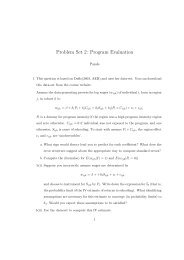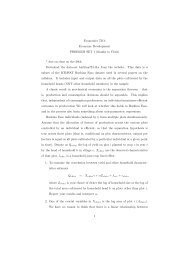The Expected Utility Model: Its Variants, Purposes, Evidence and ...
The Expected Utility Model: Its Variants, Purposes, Evidence and ...
The Expected Utility Model: Its Variants, Purposes, Evidence and ...
You also want an ePaper? Increase the reach of your titles
YUMPU automatically turns print PDFs into web optimized ePapers that Google loves.
Schoemaker: <strong>The</strong> <strong>Expected</strong> <strong>Utility</strong> <strong>Model</strong><br />
used in the construction of the model. In<br />
that case, empirical findings of field studies<br />
<strong>and</strong> realistic laboratory studies are especially<br />
relevant. However, in such studies<br />
the evidence counter to EU theory can<br />
often be refuted because it is indirect.<br />
For instance, in field studies assumptions<br />
need to be made about the values<br />
of various parameters (e.g., costs, tax rates,<br />
probabilities, etc.) as well as the form of<br />
U(x).If the data are inconsistent with certain<br />
of these prior assumptions, another<br />
set of parameters can usually be found,<br />
ex post facto, that fit the data better. To<br />
illustrate, when Peter Pashigian, Lawrence<br />
Schkade <strong>and</strong> George Menefee<br />
(1966) concluded that consumers did not<br />
act in accordance with EU theory because<br />
they bought expensive low-deductible<br />
policies for collision in automobile insurance,<br />
John Gould (1969) countered that<br />
the data were in fact consistent with certain<br />
types of sufficiently risk-averse exponential<br />
utility functions. <strong>The</strong> presumed incompatibility<br />
only applied to quadratic<br />
<strong>and</strong> logarithmic utility functions. <strong>The</strong><br />
question therefore arises, within the positivistic<br />
view, to what extent the EU hypothesis<br />
is falsifiable. <strong>The</strong> most irrefutable<br />
evidence, which directly concerns the axioms,<br />
is discounted in positive economics.<br />
On the other h<strong>and</strong>, the evidence that is<br />
admissible (e.g., actual decision making in<br />
the real world) often suffers from lack of<br />
controls, multiple interpretations, <strong>and</strong><br />
measurement problems regarding key<br />
constructs (e.g., probabilities). Some examples<br />
are provided later in the context of<br />
the capital asset pricing model in finance<br />
<strong>and</strong> studies on the effect of pension plans<br />
on private savings.<br />
Nevertheless, the distinguishing feature<br />
of a positive theory is that it yields hypotheses<br />
that are falsifiable in principle: i.e.,<br />
they meet Karl Popper's (1968) so-called<br />
demarcation criterion. <strong>The</strong> latter requires<br />
that a theory specifies clearly <strong>and</strong> a priori<br />
the conceivable empirical results which<br />
support it <strong>and</strong> those which refute it (without<br />
the latter set being empty). To distinguish<br />
between those researchers who<br />
allow falsification of the EU model in principle,<br />
<strong>and</strong> those who regard the optimality<br />
of economic behavior as an essentially unfalsifiable<br />
meta-postulate, we might distinguish<br />
a third purpose of EU models, which<br />
I shall refer to as postdictive. <strong>The</strong> essential<br />
premise of the postdictive EU view is that<br />
all observed human behavior is optimal<br />
(in the EU sense), provided it is modeled<br />
in the appropriate manner. Seeming suboptimalities<br />
are explained, ex post facto,<br />
by introducing new considerations (e.g.,<br />
costs, dimensions, constraints, etc.) that<br />
account for the anomalies, so as to make<br />
them optimal. From this perspective, satisficing<br />
(Herbert Simon, 1955) is just a<br />
more general type of optimizing, including<br />
such factors as the cost of information,<br />
decision time, constraints, <strong>and</strong> cognitive<br />
effort. It is the latter degrees of freedom,<br />
however, that may make the postdictive<br />
approach tautological: i.e., non-empirical<br />
<strong>and</strong> non-falsifiable (for a different view see<br />
Lawrence Bol<strong>and</strong>, 1981).<br />
Many economists have acknowledged<br />
the postdictive perspective in economics,<br />
some with sorrow <strong>and</strong> some with pride.<br />
For instance, Tibor Scitovsky (1976) remarked<br />
that the concept of utility maximization<br />
"set back by generations all scientific<br />
inquiry into consumer behavior, for<br />
it seemed to rule out-as a logical irnpossibility-any<br />
conflict between what man<br />
chooses to get <strong>and</strong> what will best satisfy<br />
him" @. 4). Gary Becker (1976) on the<br />
other h<strong>and</strong> views this as a strength; he<br />
acknowledges the potential for tautology<br />
or circularity in economics, especially if<br />
unobservable transaction costs are permitted<br />
ex post: "of course, postulating the existence<br />
of costs closes or 'completes' the<br />
economic approach in the same, almost<br />
tautological, way that postulating the existence<br />
of (sometimes unobserved) uses of<br />
energy completes the energy system <strong>and</strong>




